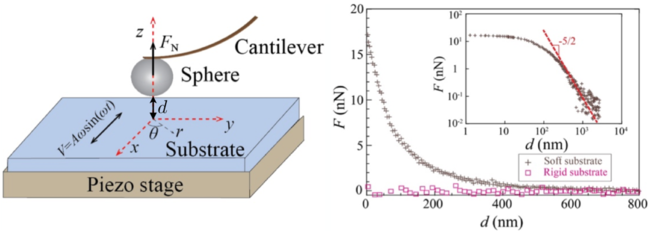Researchers from the CNRS, the University of Bordeaux and ESPCI Paris measured and modeled for the first time the emergent lift force that acts on a micrometric particle moving in a viscous fluid near a soft wall. This force could have great implications in biology and nanoscience, where such objects are widespread!
Lubrication corresponds to the hydrodynamic flow generated between two moving surfaces that are separated by a thin liquid film. It is of major importance in an industrial context, where it allows better control and reduction of friction forces (as in the case of pistons in a motor engine or in ball bearings). It prevents from solid-solid contact, which is a large source of energy dissipation and quick material deterioration. Actually, these lubrication flows are ubiquitous at very different scales, through various phenomena such as landslides, aging of cartilaginous joints, aquaplaning and red blood cells. The main point is that the pressure in such confined flows are huge so that surfaces (clay, cartilage, tire, cells, etc.) can be deformed under their action. As a consequence, the deformation modifies the hydrodynamic flow and generates an elastohydrodynamic coupling between the object motion and the soft boundary.

Atomic Force Microscope (AFM) measurements of the lift force that acts on a sphere near a wall, when the latter is submitted to lateral motion. Near a rigid surface, the force is null. At a given distance d, the softer the wall, the larger the force. The force follows a power-law with the distance with a -5/2 exponent – which is a typical feature of the elastohydrodynamic coupling.
In their study, researchers from the Laboratoires Ondes et Matière d’Aquitaine (UMR 5798, CNRS/Univ. Bordeaux) and Gulliver (UMR 7083, CNRS/ESPCI Paris, PSL Research Univ.) used the atomic force microscopy (AFM) in order to measure the elastohydrodynamic lift force quantitatively. A sphere, with a typical size of tens of micrometers is glued on the tip of a AFM cantilever and is placed near a soft substrate that moves laterally. The soft substrates are made of an elastomer : polydimethylsiloxane (PDMS), with various rigidities. No force is detected over rigid substrates. However, a lift force is measured over soft elastomers. In addition, the closer the particle to the wall, the larger the lift force is. The experiments exhibit that the force increases with the substrate velocity (and thus fluid) velocity and decreases with the wall rigidity. The measurements are in good agreement with theoretical calculations. Lastly, at very short distance, the researchers highlighted a saturation of this effect – which had been predicted theoretically but had never been observed so far.
Reference:
Direct measurement of the elastohydrodynamic lift force at the nanoscale
Zaicheng Zhang, Vincent Bertin, Muhammad Arshad, Elie Raphaël, Thomas Salez, and Abdelhamid Maali, Physical Review Letters, February 4th, DOI :10.1103/PhysRevLett.124.054502
Contact:
– Elie Raphaël, ![]()
– Vincent Bertin, ![]()

